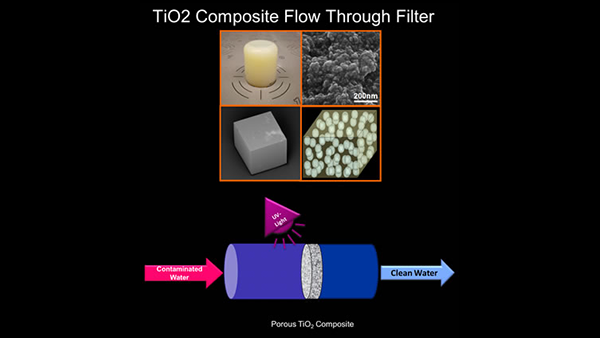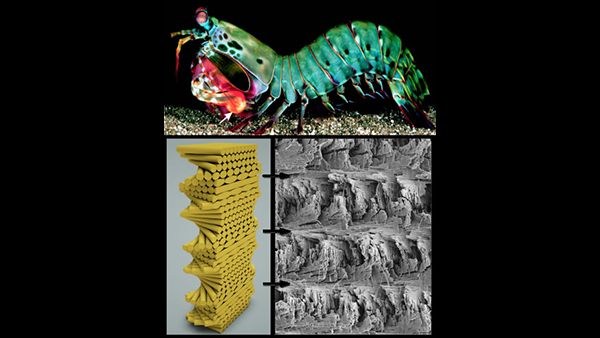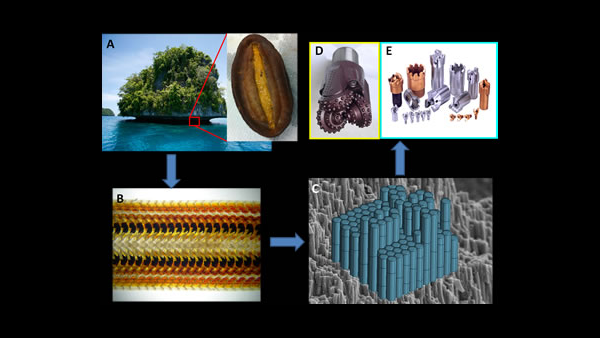Nature has evolved the capacity to utilize simple building blocks acquired from the environment to synthesize a wide range of complex structures. This is demonstrated through a multitude of biomineralized organisms that produce remarkably sophisticated three-dimensional organic-inorganic composite materials that in many aspects rival the structural, optical, and mechanical properties afforded by modern materials engineering strategies.
By learning from these organisms (housed in our 500-gallon tropical and cold water system), we aim to produce biomimetic and biologically inspired nanomaterials used in the next generation of advanced materials.
Research in the Kisailus Lab focuses on the ultrastructural investigation of biological minerals and their formation mechanisms in order to design biomimetic composite structures. The ultimate goals of our research are to develop novel "bio-inspired" synthetic processes to create organized nanostructures, which have application in energy storage (e.g., battery) and conversion (e.g., photovoltaic, photocatalytic) applications.
Dr. David Kisailus has a diverse background in chemical engineering, materials science and molecular biology. His current research group includes 2 post-doctoral researchers, 9 graduate students, and 14 undergraduate students and is highly interdisciplinary; Students come from a wide variety of backgrounds including Chemistry, Biology, Neurology, Invertebrate Zoology, Physics, Materials Science, Chemical Engineering, and Environmental Engineering. This diversity is helping us to develop bio-inspired routes to nanostructured materials.
 To accommodate the ever-increasing demand for clean drinkable water Advances Oxidation Technologies are being employed to degrade harmful compounds. One such technology uses photooxidative reactions to completely mineralize such compounds to carbon dioxide and water using Titanium dioxide. We are developing Titanium dioxide photocatalytic membranes for water treatment systems based on inspiration from biology.
To accommodate the ever-increasing demand for clean drinkable water Advances Oxidation Technologies are being employed to degrade harmful compounds. One such technology uses photooxidative reactions to completely mineralize such compounds to carbon dioxide and water using Titanium dioxide. We are developing Titanium dioxide photocatalytic membranes for water treatment systems based on inspiration from biology.  Mantis shrimp utilize a dactyl club to smash open the shells of many impressive oceanic biominerals. We are studying the structural features, such as the helicoidal design seen here in a model and fracture surface, which contribute to the material's ultra high toughness. Using advanced characterization and theory we are gleaning many insights which have lead to applicable improvements in the impact resistance of modern composite materials.
Mantis shrimp utilize a dactyl club to smash open the shells of many impressive oceanic biominerals. We are studying the structural features, such as the helicoidal design seen here in a model and fracture surface, which contribute to the material's ultra high toughness. Using advanced characterization and theory we are gleaning many insights which have lead to applicable improvements in the impact resistance of modern composite materials.  Cryptochiton Stelleri, a common inhabitant of the rocky shores of the temperate Northeastern Pacific(A), graze for algae on hard substrates using a specialized rasping organ called the radula, a conveyor belt-like structure located in the mouth( B). The radular teeth are hard and abrassion resisitant as they rasp away the rock together with algae and make the mushroom-like island (A). The goal of this project is to learn from the... read more
Cryptochiton Stelleri, a common inhabitant of the rocky shores of the temperate Northeastern Pacific(A), graze for algae on hard substrates using a specialized rasping organ called the radula, a conveyor belt-like structure located in the mouth( B). The radular teeth are hard and abrassion resisitant as they rasp away the rock together with algae and make the mushroom-like island (A). The goal of this project is to learn from the... read more

